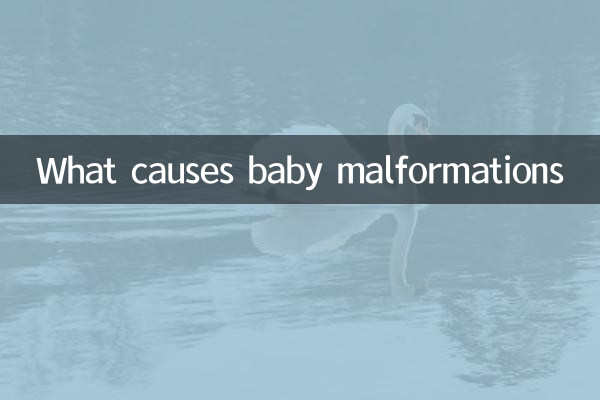What causes baby malformations
Infant malformations refer to abnormalities in the structure or function of a baby's body at birth, which may be caused by a variety of factors. In recent years, with the deepening of medical research and the impact of environmental changes, the causes of infant malformations have attracted much attention. This article will combine the hot topics and hot content on the Internet in the past 10 days, conduct a structured analysis of the common causes of infant malformations, and provide relevant data and prevention suggestions.
1. Main causes of infant malformations

The causes of infant malformations are complex and diverse, including genetic factors, environmental factors, maternal health, and bad living habits. The following are specific categories:
| Type of cause | specific factors | degree of influence |
|---|---|---|
| genetic factors | Chromosomal abnormalities, gene mutations | high |
| environmental factors | Radiation, chemical pollution, drug abuse | in |
| maternal health | Infections during pregnancy, diabetes, high blood pressure | in |
| living habits | Smoking, drinking, malnutrition | low |
2. Genetic factors and infant malformations
Genetic factors are one of the important causes of infant malformations. Chromosomal abnormalities (such as Down syndrome) and genetic mutations (such as congenital heart disease) may cause abnormal development of the baby. The following are the cases of genetic-related malformations that have been hotly discussed in the past 10 days:
| Deformity type | genetic causes | Incidence |
|---|---|---|
| down syndrome | Trisomy 21 | 1/700 |
| congenital heart disease | polygenic inheritance | 1/100 |
| spina bifida | genetic mutation | 1/1000 |
3. The impact of environmental factors on infant malformations
Environmental factors play an important role in the development of infant malformations. Hot topics recently focus on the risks of chemical contamination and radiation exposure:
| environmental factors | possible deformities | Precautions |
|---|---|---|
| Radiation (such as X-rays) | abnormal brain development | Avoid contact during pregnancy |
| Chemical contamination (e.g. pesticides) | limb deformity | Choose organic food |
| substance abuse | Multiple system malformations | Take medication as directed by your doctor |
4. Maternal health status and infant malformations
Maternal health is directly related to fetal development. Recent studies have found that infections (such as rubella, cytomegalovirus) and chronic diseases (such as diabetes) during pregnancy may increase the risk of malformations:
| maternal disease | related malformations | Prevention advice |
|---|---|---|
| diabetes during pregnancy | Macrosomia, heart defects | control blood sugar |
| rubella infection | Hearing impairment, cataracts | Vaccination before pregnancy |
| high blood pressure | Premature birth, developmental delay | Regular prenatal check-ups |
5. Potential risks of living habits
Bad living habits are preventable factors for infant deformities. Smoking, alcohol consumption and malnutrition have been hot topics of discussion on social media recently:
| living habits | risk of malformation | Improvement suggestions |
|---|---|---|
| smoking | Cleft lip and palate, low birth weight infants | quit smoking |
| drinking | fetal alcohol syndrome | Quit drinking |
| Malnutrition | neural tube defects | folic acid supplement |
6. How to prevent infant deformities
Preventing infant malformations requires multifaceted efforts:
1.Pre-pregnancy check-up: Both husband and wife should be screened for genetic diseases to ensure good health.
2.healthy lifestyle: Stop smoking and drinking, eat a balanced diet, and supplement folic acid and other nutrients.
3.avoid harmful environment: Stay away from radiation and chemical pollution during pregnancy, and use drugs with caution.
4.Regular prenatal check-ups: Early detection of potential problems with ultrasound and blood tests.
The causes of infant malformations are complex, but through scientific prevention and early intervention, the risk can be significantly reduced. We hope that the structured analysis and data in this article can help expectant parents better understand and avoid related risks.

check the details

check the details